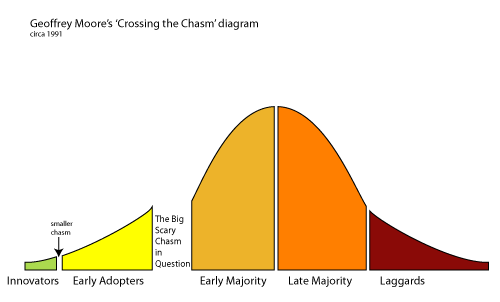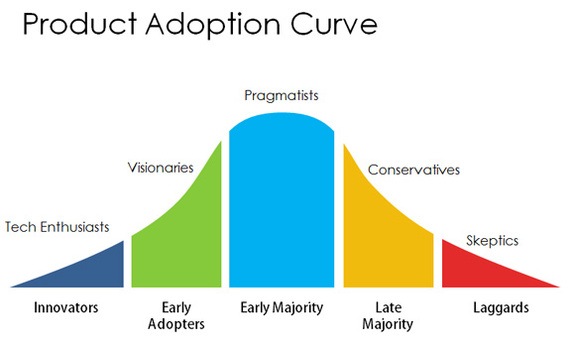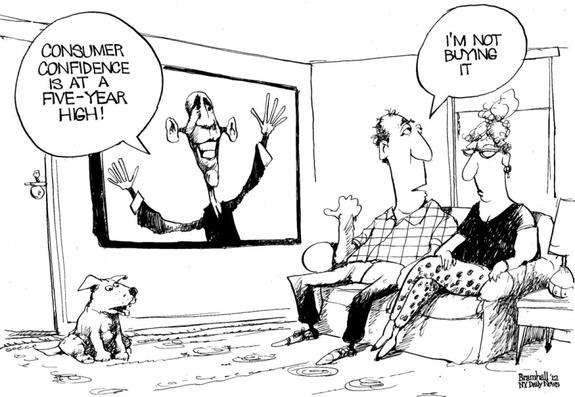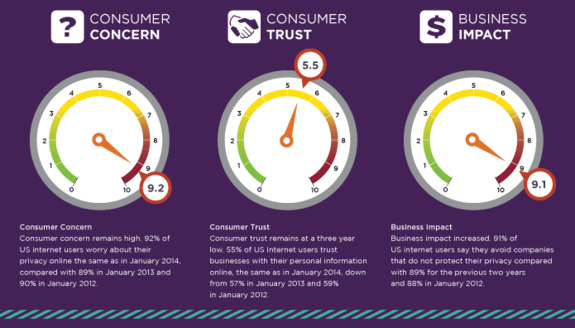Rick's Picks
Is This The End off the Early Adopter? (Part 2 of 2)
Posted By Rick Saletta on 10/06/2017 at 11:43PM
It used to be cool to be on the cutting edge. But today, it makes more sense for consumers to follow the experience of others rather than take the lead and the risk that comes with early adoption. For these reasons, educated early adopters are fleeing en-mass to the early and late majority, delaying the adoption of IoT and smart home devices, thereby preventing these companies from crossing Moore’s chasm in the time frame specified by their investors.
These consumers don’t purchase and they don’t always vote, especially when presented with two increasingly similar, but unsatisfactory, choices. Meanwhile, the classic adoption curve is skewing toward the middle of the curve, the mass market and the laggards segment, as new products that track your every move continue to be introduced while offering questionable value propositions to the buyer. It’s still cool to be smart but now it’s smart to be a late!
While there are some great new IoT Smart Home devices becoming available, including the Amazon Echo 2nd Generation, the Liftmaster 8500 Direct Drive Garage Door Opener and the Rachio 2nd Generation Smart Sprinkler control as the names suggest, these are no longer first generation technologies. Future products that incorporate AI enabled services should offer greater value propositions but they are not quite here yet.

Antennas: Cut the cable cord and switch to back to an antenna. With proper mounting, you can receive the major content delivery networks including ABC, CBS, FOX, NBC and PBS, for free. An OTA HD antenna often delivers a higher quality HD picture than Comcast and the other cable TV providers while using the remote control that actually came with your TV, not the one that tracks your every click. You will receive every broadcast NFL game that is not restricted to the pay-per-view NFL Network or ESPN. Plus, you can give back the set-top boxes, incompatible tracking remotes and extra coax cables while avoiding the routine over-billing and poor customer service.
CDs: Why settle for a 99¢ DRM restricted MP3 from the iTunes store when for a penny more, you can buy the entire album on CD and auto-rip it into iTunes or Songbird, giving you ~12 full audio-range AIFF files for your new HD Audio capable mobile device and bluetooth speakers. Think about it, no more iTunes store login errors!
BluRays & DVDs: Regaining popularity with the cord cutters and Comcast haters, for $1-$5, you can watch the movies that Netflix aged out in fully decompressed, Dolby surround sound without using up your data plan or getting your home internet connection throttled. Or, rip the disc onto your mobile device or laptop and you can take it with you and watch what you want on the plane or in the hotel.
Coffee Makers: What is the point of a remotely programmable, smart coffee maker if it does not refill itself with water?
PlayStations & Video Game Consoles: Latest generation video games have always been expensive running from $15-$50 each. While the PlayStation 3 was an architectural and short lived silo, PlayStation 2 games and consoles cost about 75% less. If you don’t mind that the MLB and MLS players have been traded to other teams and you don’t need online chat with your friends during the game, the experience is fairly similar. Last I heard, Messi still plays for Barcelona. Finally, older game controllers often lack the complexity of their newer counterparts, giving Dad’s a chance to win.
Fishing Rods and Golf Clubs: IM6 graphite shafts are still the industry standard, and if you haven’t figured out by now, buying the latest technology will not lower your handicap or catch you more fish.
Navigation Systems: “I wasn’t texting officer, I was looking at Waze.” Most cars on the lot today have integrated audio and navigation systems. But, the integrated user interfaces are awkward and difficult to manage while driving. And if you listen to a lot of music while driving, having independent, dedicated controls is both easier and potentially safer. Sure add-on devices are a little clunky, but, an older generation TomTom or Garmin includes lifetime maps and traffic updates that do not require or drain your cell phone’s battery and data plan.
Laptop Computers: Giving way to tablet innovation, the most recent generations of laptops, Mac or Windows, do not perform that much faster than their predecessors, mostly running on different variants of the Intel i7 processor. Furthermore, the new "candy glass" iphone-like touch screens are glossy, causing more rapid eye fatigue than their anti-glare predecessors. If you really want a faster computer, add some new tech to your old machine. Solid State Drives seem expensive, at first, but greatly outperform hard drives in terms of speed, reliability and reduced power consumption. Replace your hard drive with an SSD and benefit from faster, quieter, cooler performance as well as extended battery life.
Refrigerators: I’m still waiting for Samsung's inside sales to email a reply to me explaining the value proposition of the touch screen on the front of their new model, wifi refrigerators. When I find one, I'll let you know.
Slingbox M1 or older: Don’t buy the newest M2 model. It only subjects you to increased and unwanted advertising with no additional value proposition for the consumer.
Tablet Computers: Marshmallow (Android v6) added more granular privacy controls to the settings. But, I’m still not sure why I need Android Nougat or Android Oreo. The last time I migrated to a newer tablet, the Google migration tool only installed a third of the apps that needed to be migrated. It just wasn't worth the time.
Toasters: Press button to toast. It still works.
Televisions: If you have or are considering reading glasses, you probably don’t need 4K.
Tags: iot, smart home, early adopter, adoption curve, iphone, android, tablet computing
Is This The End of the Early Adopter? (Part 1 of 2)
Posted By Rick Saletta on 10/03/2017 at 11:36AM
For forty-four years, business schoolers and marketers have been taught that consumers fit into market segments defined by the classic adoption curve, and, that product lines should target individual market segments. However, with the emergence of the web-app economy, the classic adoption curve had begun to break down.

With classic product development methodology, it was generally understood that product marketers would refine features in an “alpha” testing process for a select few, trusted testers. After which, a feature complete “beta” product would be released to a larger group of testers who would benefit from early access and who were also willing to submit feedback to help eliminate bugs and improve product quality, prior to a general release.
However, Google’s multi-year beta process for Gmail essentially devalued the definition of the "beta” process by keeping software users in an indefinite beta period while adding and removing new features during the beta period. While an indefinite beta period is a trial of sorts, it is not unlike keeping a crime suspect indefinitely in-prisoned without a trial. Extended public betas keep customers in limbo, causing the deferral of substitute purchases and deployments. "Just get it into public beta” is the mantra. Extended public betas are becoming the new norm in the web app economy, yet quality does not appear to be increasing.
Innovators and early adopters have always been somewhat willing to tolerate the flaws in early release products to get access to the newest and coolest stuff. But, the web app economy has been driven by the democratization of app development. As often seen in democracies, the voters’ choices boil down to the lowest common denominators. Low quality. free software aka “crApps” in the app-stores is the new normal. Apps that have not been tested by the masses and reviewed in an App Store are too risky for most to install on a mission critical devices such as a personal cell phone or laptop for fear of malware, caching problems that will slow the device to a halt, stealing ones address book or even a virus. Yet, most consumers do not calculate the risk until after their devices crash or grind to a halt. It takes a telecom six months to test an app on a phone before releasing it, but only sixty seconds for a consumer to install an untested app.
Simultaneously, the trend among large corporations and start-ups alike is to release what is called an MVP, a "Minimally Viable Product,” as quickly as possible. And, here’s the catch. More and more of these device MVPs are targeting millenials. But, millenials don’t buy. They don’t buy cars (Uber) they don’t buy vacation homes (AirBnB), they don’t buy movies (NetFlix). While this trend is permeating the older generations, it is the Baby Boomers and Generation X consumers who now have the pocket cash to buy but are concerned that new technology won’t be secure and wont work with existing infrastructure. They have the experience and have seen this act before. Everything is an IT project, or to be buzzword compliant, an IoT project.
As for IoT adoption, the connection of mission critical home products such as refrigerators and door locks poses greater risk than reward. Educated consumers have seen this cycle before. Do you really want a minimally viable product running in your phone, your car or your home?
Despite the risks, we find ourselves in a web app beta culture with perpetual software updates, bug fixes and installation glitches. Even more so, independent developers and corporations alike will frequently use these updates as an opportunity to reset consumer privacy permissions and mine device for data. Thousands will stand in line to get the new iPhone 7. But, educated consumers (formerly early adopters) are learning to defer their purchase cycle and wait for the remaining early adopters to be used as crash test dummies while their Samsung batteries catch on fire. Like riders in the Olympic velodrome, there is a strategic advantage to staying behind.

Tags: iot early adopter adoption curve smart home consumer
Ready Fire Aim! Smart Home Devices Are Missing The Mark.
Posted By Rick Saletta on 05/16/2016 at 07:45AM
 Following-up recent IoT activities, events and announcements, a survey published by Truste (the company that offers the really annoying product that pops-up and then asks you for site feedback before you’ve even tried the website you are visiting), states that consumer trust remains at a three year low with slightly more than half of internet users trusting companies with their personal information.
Following-up recent IoT activities, events and announcements, a survey published by Truste (the company that offers the really annoying product that pops-up and then asks you for site feedback before you’ve even tried the website you are visiting), states that consumer trust remains at a three year low with slightly more than half of internet users trusting companies with their personal information.
This month we’ve seen the release of dozens of smart home and other connected devices, many new and cool, but many without value proposition or purpose and with little or no consumer research conducted prior to prototyping. There appears to be a pack mentality to launch now and iterate later. With consumer privacy concerns on the rise and early-stage market research under-funded, most of these young companies will never reach volume production. Instead the larger, slower public corporations are expressing their gratitude to the entrepreneurs and investors who fail fast, developing new markets with their own capital.
Tags: iot smart home privacy trust consumer confidence
A Tale of Two IoT Meet-Ups: Where’s the Beef?
Posted By Rick Saletta on 05/10/2016 at 11:48AM
Over the last couple weeks I attended a pair of Smart Home / IoT related meet-ups. The first was sponsored by Philips Lighting at the Sunnyvale Plug N’ Play center, an incubator and office space for start-ups that is known for hosting interesting events that mix start-ups, partners and investors. The second was at the Target Open House in San Francisco.

Philips keeps office space at the Plug N’ Play Center to identify and work with new technology start-ups. The most useful info from the presentation was that Philips has 3 divisions, one focused on home. It’s appeared that Philips walked upstairs and brought 1 Hue lamp to demo. It was a POE lamp (Power Over Ethernet) which made it interesting for a few seconds.
At the Philips tables, there was nothing to demo, simply a couple of partner managers waiting for start-ups to bring their ideas. I overheard one founder say “Do they really expect us to stand here and tell them our ideas?” Another asked, “We came here; what do you have to offer start-ups?” This Philips lighting event was void of content, sub-par for Plug N’ Play, as was the pizza, but at least there time to network.
At the other end of the Bay is Target. Target recently constructed a one story model home near the San Francisco Metreon to demonstrate Smart Home products. They routinely host events, this one called “Investing in the Future of IoT” It was really good to see so many Smart Home solutions and devices lined-up together and functioning. The food was catered, the networking was quite good and the investor panel was insightful. Panelists included:
Hanns Anders, Investment Manager at iRobot Ventures
Mark Valdez, Principal at Playground Global
Varun Jain, VC at Qualcomm Ventures
Kate McAndrew, VC at Bolt VC
Still, some of these early Smart Home & IoT devices left attendees wondering “Where’s the value proposition?” Why do I need a smart kitchen scale that displays the measured weight on my tablet? How useful is a smart coffee maker that you can turn on from your cell phone when the coffee maker lacks a water intake valve? These so called “smart” devices are connected not intelligent. Connected does not always mean more useful but it often it means more things can go wrong.
One of the most thoughtful product innovations i saw was a fully trasnparent, lucite crib so you can see the baby from all angles. Then, I realized the lucite crib is was just a prop in the model home. Reflecting on these two events, just imagine the situation comedy if Ron Howard were to revive Arrested Development as a Smart Home :)

Tags: iot smart home security ott target philips
If You Build It, Will They Come?
Posted By Rick Saletta on 04/12/2016 at 08:03AM
Personal data security and personal privacy are the top two consumer considerations when choosing to defer the purchase of a Smart Home IoT
device or service. No longer do consumers consider these devices "High-Tech." Instead, they are simply the miniaturization and integration of existing technologies and services that collect consumer data.
Companies are building OTT boxes, devices and apps for the services they want to sell, frequently foregoing traditional market research that would identify whether or not this is a service that consumers are actually ready to buy. Having experienced a two year Gmail beta and the now too common release of not ready for prime time products, the default purchasing position for consumers is now to defer the purchase of new technology.

Tags: iot smart home security ott over the top


